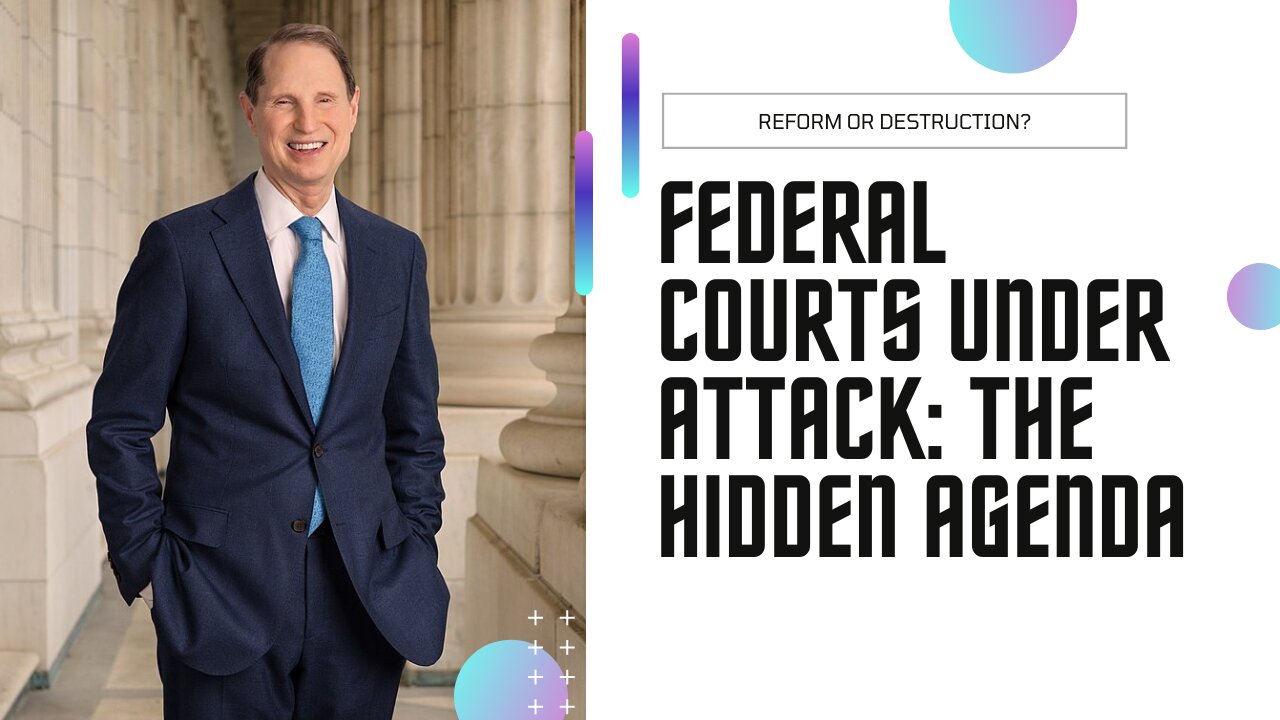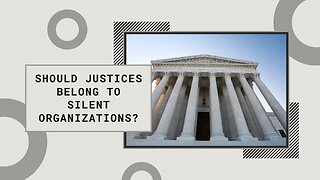Premium Only Content

Federal courts – a Democratic remake
Federal courts – a Democratic remake
By Terry A. Hurlbut
The ideology of the Democratic Party has suffered greatly in the federal courts during the Biden term. Donald J. Trump appointed three Justice of the Supreme Court, and equally significant numbers of District and Circuit Appellate Judges. These appointments steered the federal courts toward greater (but not perfect) fidelity to the Constitution. As a result, the tension between the judiciary and the political branches (Executive and Legislative) of the federal government has never been greater. Not even Franklin D. Roosevelt attacked the judiciary as one Democratic Senator has just done. His measure stands little chance of passage. But his audacity to introduce it demonstrates why control of the United States Senate is a vital election stake.
Ron Wyden’s grievances against the federal courts
Sen. Ron Wyden (D-Ore.) introduced S. 5229, the “Judicial Modernization and Transparency Act,” last Wednesday (September 25). The full text of the bill is available only at Wyden’s “Web office,” but CNAV also hosts it here:
Sen. Wyden described his bill in a press release, and one can follow its progress at GovTrack.us and Congress.gov. In his press release, the Senator mentions “ recent rulings upending decades of precedent and evidence of unethical behavior.” Those recent rulings include every ruling that has blocked favorite Democratic Party nostrums, including without limits:
• Abortion, particularly abortion on demand for any reason or no reason,
• Gun control, especially what constitutes a “machine gun” under current law,
• Censorship under color of apparently unrelated law,
• Exclusion of God from the public square and especially in schools (see here and here),
• The unlimited power of the Administrative State, and especially the “Chevron Deference Doctrine,”
• Enforced acceptance and even celebration of Alphabet Soup and similar alternative lifestyles, and
• Diversity, Equity and Inclusion (DEI), once known as “affirmative action,” in college admissions.
The Court also blocked the administration from unilaterally forcing taxpayers to assume student loan repayment burdens. But what especially rankles with Sen. Wyden were the Court’s decisions to:
• Limit the applicability of a financial-records destruction statute to charges relating to the January 6 Event, and to:
• Define and delineate Presidential immunity from prosecution for certain classes of his acts.
Not all rulings would have displeased the Democrats
Not all Supreme Court decisions displeased Sen. Wyden. For instance, he said nothing about the Supreme Court vacating an injunction against social media acting as State actors. Separately, Justice Clarence Thomas remonstrated with his colleagues for magically thinking a law could substitute for a target acquiring and using the means of self-defense.
But that’s not good enough for Sen. Wyden. Among other things, he seems to feel that Congress should have enhanced authority to rewrite the Constitution. Furthermore, by “rulings” he includes those from District Courts and Circuit Courts of Appeals – especially the Fifth Circuit.
He also has taken up the refrain of Democrats and their allied think tanks, against at least two Justices. Justice Thomas they attack by association with his wife, Virginia Lamp Thomas, and some of her affiliations. Those same detractors attack Justice Samuel A. Alito for flying flags indicating the distress of the United States, and a call for return to the values that informed the American War for Independence. The Democrats seem to feel that this makes the Court no longer neutral. In essence they feel that values inimical to the Constitution are just as legitimate as values friendly to it. Nor can they amend the Constitution, nor remove Thomas and Alito JJ through impeachment, because they lack adequate support. So – with Sen. Wyden currently leading them – they are trying the next best thing.
Remaking the Supreme and other federal courts in the Democrats’ image
The text of S. 5229 is impossible to read without reference to Title 28 of the United States Code. That Title deals with the composition and organization of the Supreme and other federal courts. Chapter 1 covers the Supreme Court, and Chapter 3 covers the Courts of Appeals.
The Wyden bill increases the full membership of the Supreme Court from 9 to 15, and resets the quorum level from 6 to 8. The next sections will create confusion. Presidents shall appoint one new Justice in the first 120 days of the first and third years of their terms. But the bill also provides that Presidents shall nominate Justices to fill vacancies on the Court.
What is a vacancy, and how does a vacancy differ from the “general” condition? No doubt Sen. Wyden will argue that the creation of a new seat on the Court, by his bill or by any future legislation, shall not constitute a “vacancy” allowing of immediate filling. A vacancy would then mean “in case of the removal of a Justice of the Supreme Court from the bench, or of his death or resignation.” But the bill does not say that. CNAV finds this language deceptive, and holds that it allows Presidents to appoint new Justices at once. Whether to replace a removed, dead, or resigned Justice, or to fill a legislatively created seat, would constitute a vacancy. So any determined President would argue.
Forcing the Senate’s hand, and tax audits
In light of the Senate’s sensible decision not to act on the nomination of Merrick Garland, the Wyden bill would force the Senate to act. To do that, his bill would automatically discharge a held-up nomination out of Committee and to the Senate floor. Technically, the nomination would go onto the calendar – perhaps subject to manipulation by Senate Leadership. Tellingly, this would not apply to the nomination of any judge lower than a Justice of the Supreme Court.
What would apply, is an automatic income tax audit by the Internal Revenue Service. Furthermore, Justice candidates would have to disclose three years’ worth of tax returns. By far this constitutes the bulk of the text, covering all possible exceptions and contingencies.
Forcing disclosure of Supreme Court votes
As arrogant as this is, this bill would directly change the Rules of the Supreme Court with regard to:
• Motions for recusal by reason of prior association with a party or for other reasons, and
• Votes in conference on every matter relevant to any given case.
Normally the Court discloses the votes of Justices only in decisions in the cases they accept for review. One infers those votes by tallying majority, concurring, and dissenting opinions, and joinders of such opinions. In addition, any Justice may, if he wishes, disclose his dissenting vote in proceedings other than review decisions. This includes decisions to grant or deny review petitions, and applications for injunctions, stays of injunctions, stays of executions, etc. But under the Wyden bill, every vote in every case would be subject to a detailed vote tally disclosure. Compelling that kind of disclosure can have one purpose only: to influence Court decision making. That directly violates existing criminal law about trying to influence the course of justice.
The Wyden Bill also would require supermajorities to invalidate any Act of Congress on Constitutional grounds. Presently, simple majorities of any three-judge panel, a full appellate court rehearing a case en banc, or the Supreme Court can suffice. The Wyden Bill would now require:
• Unanimous panel decisions, and
• Two-thirds supermajorities of the Supreme Court or a Court of Appeals sitting en banc.
That way lies informal, gradual, and no less permanent amendment of the Constitution.
Changing the Courts of Appeals
Presently the federal courts include thirteen Courts of Appeals, for eleven regional circuits and two special federal government circuits. The current composition of the circuits is:
The thirteen judicial circuits of the United States are constituted as follows:
Circuits
Composition
District of Columbia
District of Columbia, Alien Terrorist Removal Court
First
Maine, Massachusetts, New Hampshire, Puerto Rico, Rhode Island.
Second
Connecticut, New York, Vermont.
Third
Delaware, New Jersey, Pennsylvania, Virgin Islands.
Fourth
Maryland, North Carolina, South Carolina, Virginia, West Virginia.
Fifth
Louisiana, Mississippi, Texas.
Sixth
Kentucky, Michigan, Ohio, Tennessee.
Seventh
Illinois, Indiana, Wisconsin.
Eighth
Arkansas, Iowa, Minnesota, Missouri, Nebraska, North Dakota, South Dakota.
Ninth
Alaska, Arizona, California, Idaho, Montana, Nevada, Oregon, Washington, Guam, Hawaii, and the Northern Mariana Islands.
Tenth
Colorado, Kansas, New Mexico, Oklahoma, Utah, Wyoming.
Eleventh
Alabama, Florida, Georgia.
Federal
Courts of Federal Claims, International Claims, and Appeals for Veterans’ Claims, plus nine independent administrative agencies
The Wyden Bill would plump this number out to fifteen, so that one Jusice could oversee one Circuit. Perhaps the Chief Justice would supervise the District of Columbia Circuit, but who knows who would supervise the Federal Circuit? But Wyden also proposes to change the compositions of the numbered regional circuits radically.
New circuits for the federal courts
Part of the purpose is to create fifteen circuits instead of the thirteen listed above. That alone would require splitting some circuits. But Wyden also seeks to break the power of some circuits by reconfiguring them. The new table would read:
Circuits
Composition
District of Columbia
District of Columbia, Alien Terrorist Removal Court
First
Maine, Massachusetts, New Hampshire, Puerto Rico, Rhode Island.
Second
Connecticut, New York, Vermont.
Third
Delaware, New Jersey, Pennsylvania, Virgin Islands.
Fourth
Maryland, North Carolina, South Carolina, Virginia, West Virginia.
Fifth
Arkansas, Louisiana, Mississippi, Tennessee.
Sixth
Kentucky, Michigan, Ohio.
Seventh
Illinois, Indiana, Wisconsin.
Eighth
Iowa, Minnesota, Missouri, Nebraska, North Dakota, South Dakota.
Ninth
California, Guam, Hawaii, and the Northern Mariana Islands.
Tenth
Colorado, Kansas, Oklahoma, Utah, Wyoming.
Eleventh
Alabama, Florida, Georgia.
Twelfth
Arizona, New Mexico, Texas
Thirteenth
Alaska, Idaho, Montana, Nevada, Oregon, Washington
Federal
Courts of Federal Claims, International Claims, and Appeals for Veterans’ Claims, plus nine independent administrative agencies
Texas would now have to contend with ultra-liberal New Mexico instead of reasonably conservative Louisiana. Alaska, Idaho, Montana and Nevada would exchange one albatross (San Francisco, California) for another (Portland, Oregon, perhaps).
Finally, Wyden seeks to plump out the federal courts with a hundred additional District Judges. The text of his bill says nothing about creating new Districts. But of course creating two new numbered regional circuits would create new appellate circuit judgeships. Wyden also proposes adding several circuit judges to most circuits.
The most dangerous change to the federal courts
By far the most dangerous change to the federal courts, that affects the balance of power in the judiciary, is the new Paragraph (c) of 28 U.S.C. Section 42. Presently that section has two paragraphs, currently not designated. Wyden would designate those paragraphs as (a) and (b). Paragraph (b) would specify one Justice for one circuit, as above. Paragraph (c) would add new powers and duties to a supervising “circuit Justice” as follows:
(c) A circuit justice may—
(1) prioritize applications to justices; and
(2) participate in committees to prepare for the Judicial Conference of the United States;
(3) attend the Judicial Conference of the United States; and
(4) provide advice on the removal of a circuit judge in the circuit to which the circuit justice is assigned.
This would give memberships in the Judicial Conference to all Supreme Court Justices, not the Chief Justice alone. Currently the Judicial Conference consists of:
• The Chief Justice,
• Chief judges of all circuits,
• The chief judge of the Court of International Trade, and
• One district judge from each numbered regional circuit.
Changing the composition of the Judicial Conference can only be some kind of power play; CNAV is not sure what.
Affecting the balance of power
More to the point: currently, circuit Justices simply forward applications for injunctions/stays to the Court without comment. This would let Justices hold certain applications up as they see fit. The Justice also gains the power to advise removing someone from the Court of Appeals. That can have one purpose only: to change the composition of the Courts of Appeals other than through Congressional impeachment.
All these changes would significantly change the balance of power in the federal courts. The Supreme Court would become far more powerful than Congress has heretofore intended. It would even have the power, however indirect, to remove existing circuit judges.
Wyden would also create over a hundred additional District judgeships. Tellingly, he does not stagger the appointments of these new judges, or of new circuit judges either. And again, “what constitutes a vacancy at the Supreme Court” would be subject to argument.
Reaction
Mike LaChance at The Gateway Pundit published a scathing account of the new bill last night (September 27). He correctly noted the scheme to enlarge the Supreme Court – though he missed the significance of the bill’s Vacancy clause. Nor did he mention that The Washington Post made the same mistake he made:
The bill’s most significant measure would increase the number of justices from nine to 15 over the course of 12 years. The staggered format over two or three administrations is aimed at diminishing the chance that one political party would pack the courts with its nominees.
Yes, but! What constitutes a vacancy? Wyden’s bill doesn’t say. The Post did mention the concurrent expansion of the District and Appellate Circuit Benches.
Carrie Severino of Judicial Network left a long-form post on X expressing her displeasure:
🚨With 40 days until Election Day, Democrats just rolled out the most radical and dangerous legislation to date aimed at destroying the Supreme Court as we know it. The new radical bill put forward by Senate Democrats is the worst attack on the Court since FDR. It will:
❌Pack the Supreme Court with 6 more justices.
❌Harass the justices with mandatory yearly IRS audits.
❌Require a ruling by two-thirds of the Supreme Court and the circuit courts of appeals to overturn a law passed by Congress rather than a simple Court majority.
❌Expand the number of federal judicial circuits from 13 to 15 — adding more than 100 district court judges and more than 60 appellate-level judges — so Democrats can stack the federal bench with more unfit radicals.
❌Weaken the Senate’s power of advice and consent by requiring Supreme Court nominees to be automatically scheduled for a vote if their nominations stall in committee.
https://x.com/JCNSeverino/status/1839369331664130533
Ms. Severino then names four Democratic Senators up for reelection in swing States. They are Sens. Jon Tester (D-Mont.), Bob Casey (D-Pa.), Jacky Rosen (D-Nev.), and Sherrod Brown (D-Ohio).
GovTrack.us gives this bill a two percent chance of passage in the current term of Congress. But it puts the Democrats on record for a shameless attempt to make the federal courts dance to their tune. Which goes to show that Senate elections, not only Presidential elections, have consequences.
Link to:
The article:
https://cnav.news/2024/09/28/foundation/constitution/federal-courts-democratic-remake/
Sen. Ron Wyden (D-Ore.) “Web office”:
https://www.wyden.senate.gov/
S. 5229:
Text:
https://www.wyden.senate.gov/imo/media/doc/judicial_modernization_and_transparency_act.pdf
Wyden’s press release:
https://www.wyden.senate.gov/news/press-releases/wyden-introduces-sweeping-court-reforms-to-restore-public-trust-as-supreme-court-faces-legitimacy-crisis
Profile at GovTrack.us:
https://www.govtrack.us/congress/bills/118/s5229
Profile at Congress.gov:
https://www.congress.gov/bill/118th-congress/senate-bill/5229
Title 28 USC:
https://www.govinfo.gov/content/pkg/USCODE-2011-title28/html/USCODE-2011-title28.htm
Official description of the Judicial Conference of the United States:
https://www.uscourts.gov/about-federal-courts/governance-judicial-conference/about-judicial-conference
Mike LaChance’ article:
https://www.thegatewaypundit.com/2024/09/it-begins-democrat-senator-ron-wyden-oregon-pushes/
Washington Post article (per the Wayback Machine, thus avoiding the paywall):
https://web.archive.org/web/20240927035126/https://www.washingtonpost.com/politics/2024/09/26/supreme-court-reform-15-justices-wyden/
Carrie Severino’s post:
https://x.com/JCNSeverino/status/1839369331664130533
Declarations of Truth X feed:
https://x.com/DecTruth
Declarations of Truth Locals Community:
https://declarationsoftruth.locals.com/
Conservative News and Views:
https://cnav.news/
Clixnet Media
https://clixnet.com/
-
 20:36
20:36
Declarations of Truth
30 days agoRoberts CJ in a judicial silent organization?
170 -
 LIVE
LIVE
SpartakusLIVE
7 hours agoGames w/ StoneMountain64 || Duos w/ StevieT into the night
633 watching -
 1:34:18
1:34:18
JustPearlyThings
5 hours agoHigh Value Men Are Happy With Wives That Are Mid (Call-in Show) | Pearl Daily
39.2K24 -
 10:32:15
10:32:15
ttvglamourx
12 hours ago $1.99 earnedBIRTHDAY STREAM !DISCORD
26.4K10 -
![[Macho Madness] Featuring G2G, Lanc & Mochi [ Fortnite --> Ghost Recon Wild Lands ]](https://1a-1791.com/video/fww1/fe/s8/1/h/g/6/D/hg6Dy.0kob-small-Macho-Madness-Featuring-G2G.jpg) LIVE
LIVE
CHiLi XDD
7 hours ago[Macho Madness] Featuring G2G, Lanc & Mochi [ Fortnite --> Ghost Recon Wild Lands ]
97 watching -
 2:17:35
2:17:35
We Like Shooting
17 hours ago $2.16 earnedWe Like Shooting 607 (Gun Podcast)
32.9K2 -
 2:01:40
2:01:40
Joker Effect
4 hours agoYOU WOULD NEVER CLICK THIS BECAUSE YOU ARE SCARED YOU WILL LOVE IT.
27.9K2 -
 UPCOMING
UPCOMING
Anthony Rogers
1 day agoEpisode 363 - Can A.I. Be Used to Talk to the Dead?
17.5K2 -
 6:14:39
6:14:39
Meisters of Madness
7 hours agoThe Umbral Playthrough - Part 2
18.5K1 -
 58:57
58:57
Donald Trump Jr.
8 hours agoAmerica First, Always. Interviews with Ned Ryun & Kenny Cody | TRIGGERED Ep.235
141K89